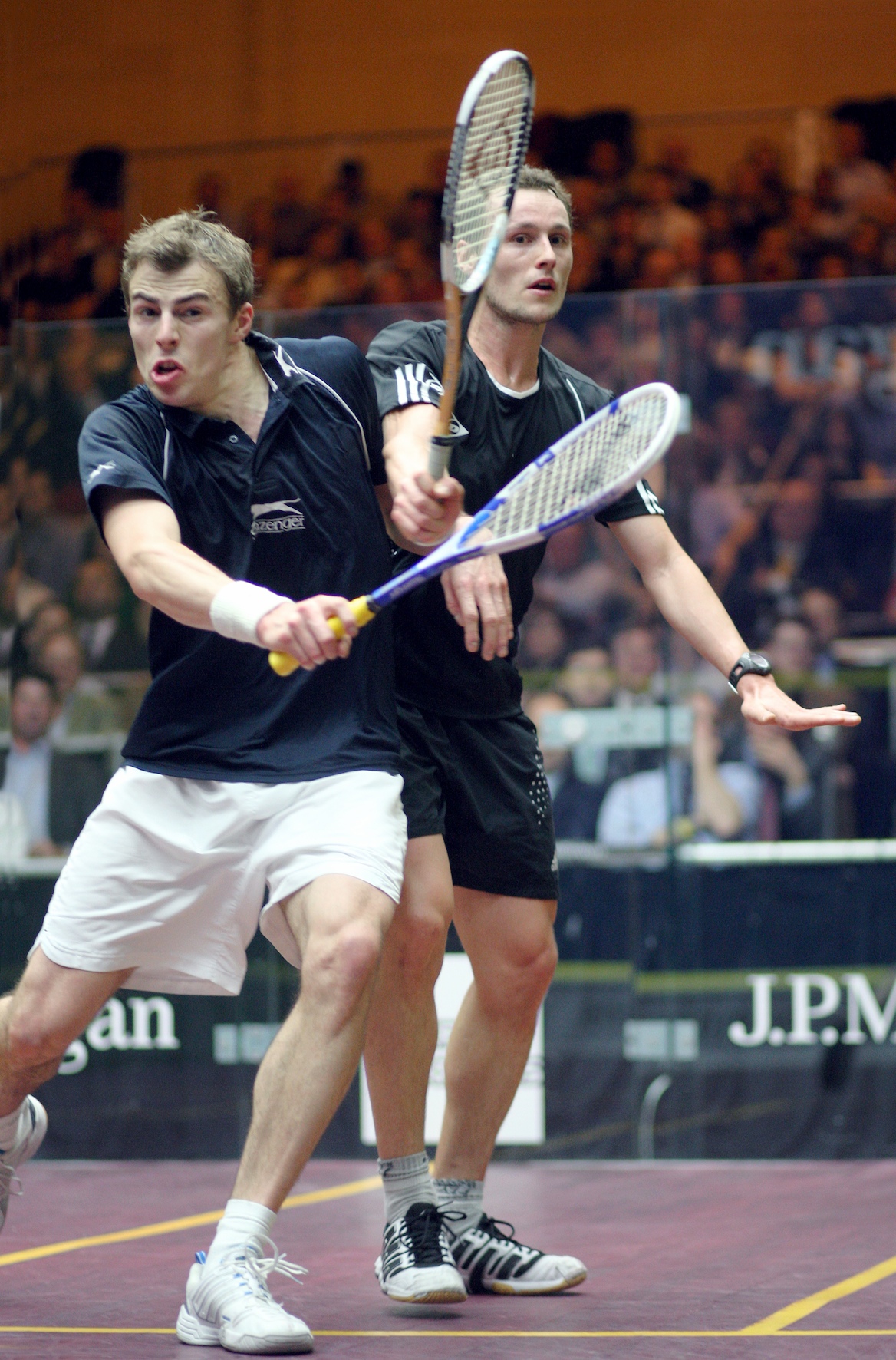
By James Zug
Photos by Steve Line/SquashPics.com
Remember Kurt Hulton’s 1934 photograph of Grand Central? Soft shafts of light streaming down on the tiny, doll-like people meeting and parting and hurrying. But exactly three-quarters of a century later, any reader of this magazine thinks: oh, just out of the frame of the Hulton pic is where John Nimick hangs those thirty-foot banners advertising the JPMorgan Tournament of Champions—that man astride the world with racquet and trophy in hand—and just there, right next to that glorious beam of sunlight is the entrance to Vanderbilt Hall. It is impossible now, after eleven ToC staged there, to think, talk or visit Grand Central without moving beyond old memories and the sounds of a thousand footfalls and landmark images to the fact of a squash match in the great train station.
Grand Central equals squash.
Yet, the equation is ever fresh. The 75th edition of the ToC offered the great pleasure of beginning not at some posh, private club or a health club that costs you a C-note a month to enter but at an eight-court glassy gorgeous urban squash facility on 115th Street. The first balls of the ToC were swatted in the qualifying round up at the SL Green StreetSquash Center. The most interesting qualies result came courtesy of 41-year-old Chris Walker, in town for the North American Open doubles tourney in Greenwich. Walker got past 25-year-old Eric Galvez, who was in diapers when Walker played in his first pro event
StreetSquash also hosted the first-ever ToC Juniors, a small U17 and U15 tournament; Amanda Sobhy ran rampant in the U17s, losing just 23 points (PAR to 11) in three matches.
More and more, the ToC is an anchor for the biggest week of squash in the country. Hundreds of players and 21 pages of draws summed up the Grand Open, the Met SRA’s amateur draw. Nonprofits coordinate with the ToC, and not just the expected StreetSquash and CitySquash programs, but ones like PowerPlay NYC, the High School of Sports Management and the Metropolitan Corporate Academy. The ToC is a true grassroots phenomena—there’s a guy at my club in Washington who meets up with his brothers once a year, at the ToC—and a real sense that the city embraces the tournament.
Indeed, the McWil Courtwall portable four-wall court saw a whole lot of action besides the main event. For sponsors, there were two nights of exhibitions and pro-ams leading up to the unusual Friday night start (the court was up in Vandy Hall for a record nine nights). In the annual teaching pro NYC Club Pro Challenge, Ben Gould showed why he is feared on the doubles court with two whitewash victories over Jonny Smith and Clive Leach. Gould got to No. 47 in the world in singles; clearly he might have gone higher. Local favorite Natalie Grainger, who saw her name on one of the ToC banners in the main hall, won 3-1 in a finals-night women’s exhibition over Laura Lengthorn-Massaro.
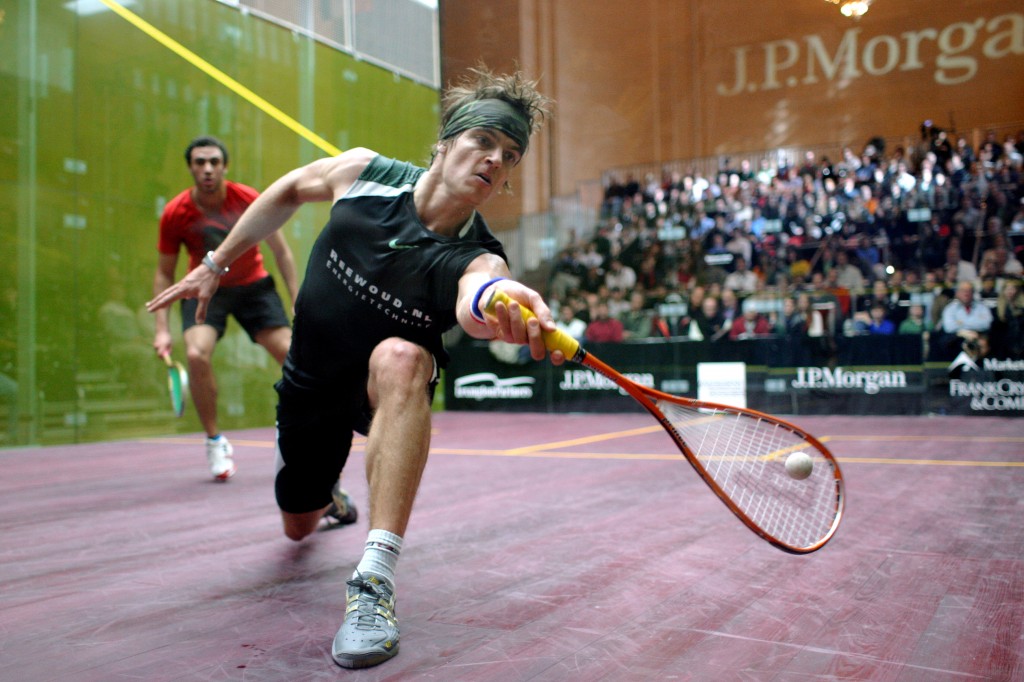
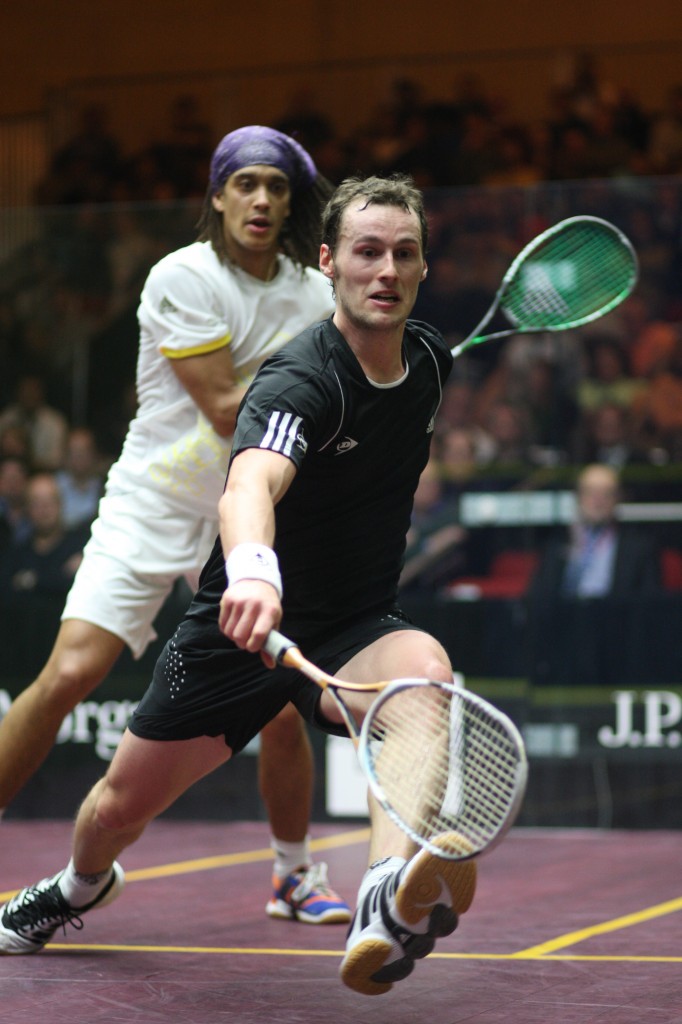
And on Monday afternoon, when normally the quarterfinalists are getting in a little practice, the court hosted ToC Pong. A fundraiser for Big Brothers Big Sisters of New York City ($10,000 got raised), the event had Nimick drop a regulation table tennis table inside the court. It was a real tournament: 13 teams of two, five hours of sizzling chops. In the final Harvest Capital Management beat Spin New York.
Seventy-five years makes the tournament the oldest pro event in the world, yet for the last two decades the home team has had little to cheer for. Not since Kenton Jernigan won the 1991 ToC at the Winter Garden has there been so much expectation for an American to go far in the draw. Unfortunately, Julian Illingworth, who made the second round each of the last two years, got chopped up pretty badly in his opening round set-to with Thierry Lincou, but he managed to stay on court for forty minutes against the former World No. 1, Since he turned 25 during the tournament, there really is a wait-till-next-year feeling about the four-time US champion.
That same night had the two most exciting players in the world, Ramy Ashour and Amr Shabana, on the bill, as well as Hashim and Sharif Khan in the stands, so the tournament could not have had a more attractive, historic start. Karim Darwish, Shabana and Ashour held the top three spots on the pro tour—amazingly it was the first time since the tour started rankings in the early 1980s that the top three all hailed from the same country; you had to go back to the early 1960s when the Khan family dominated to find a time when the top trio carried the same flag. Also in New York, moreover, were nine more of these electric, elegant, non-eleemosynary Egyptians.
But none of the Egyptian dozen made it to the finals. Yes, it was perhaps because it was the strongest field in ToC history, with 23 of the world’s top 26 players. But it was also a lack of mettle.
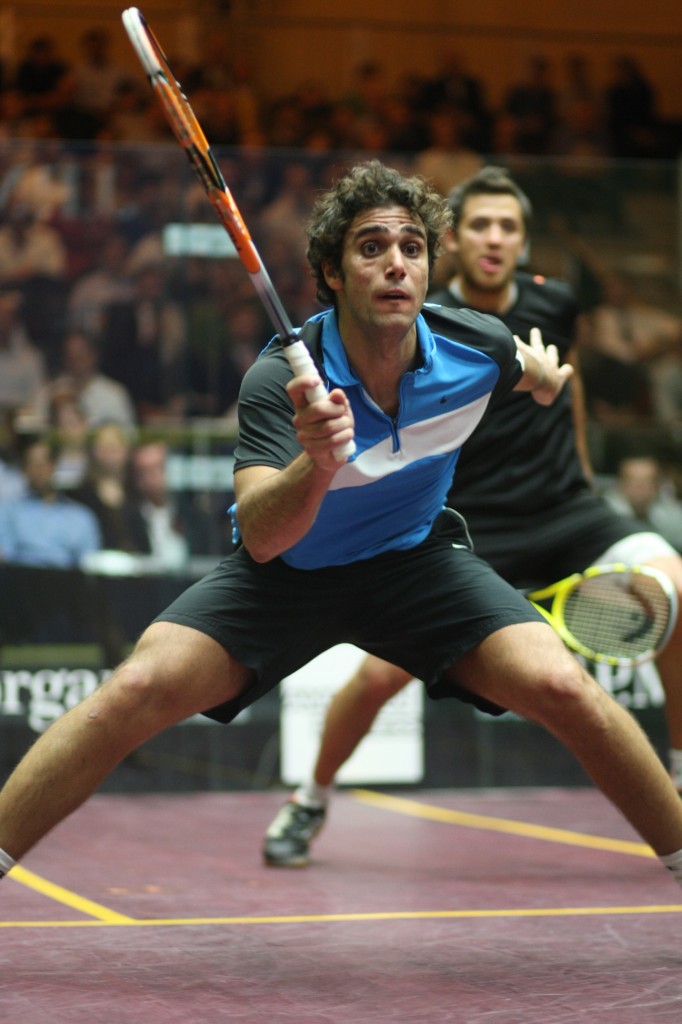
Ashour, the current world champion, never looked good. He had a couple of very tight games with Cameron Pilley in the opening round: it was 1-1, 5-all in the third before Ashour got untracked. Then he survived a massive effort from LJ Anjema who lives in The Hague now and thus gets the incredible satisfaction to say that he lives in a city that has a “The” in its name. Ashour won 11-9, 3-11, 12-10, 11-13, 11-9 ; in the fifth Anjema was up 9-7 and surely thinking that he might get The Win. “I feel like I have lost my technique, which is the worst thing that can happen to a squash player,” Ashour told Beth Rasin, ToC media guru, after the match. “When I got out on the court today, I felt like everything was happening all at once.” Ashour then bit more nails in a four-gamer against Lincou that featured three overtime games; Lincou squandered five game points during the match. In the semis Ashour went down meekly to Nick Matthew, who had also gotten past Shabana when the Cairene withdrew in the second game due to a dodgy knee.
Karim Darwish, who took over from Shabana as World No. 1, looked eminently human in his 3-1 semifinal loss to Gregory Gaultier. He had appeared untouchable in early rounds, but he simply could not match up with Gaultier, shot for shot, rally for rally. In the end, he lost patience. Juxtaposed to Ashour and Shabana, Darwish has a joyless game.
In the final, Matthew, who missed nine months of last year’s season due to a shoulder injury and thus was the tenth seed at the ToC, was feeling fresh. But Gaultier, the fourth seed, was on a roll. He was in his fourth PSA final in a row, he had beaten Matthew in their last four meetings (3-0 in the last two) and he was no longer skidding through error patches that had plagued him earlier in his career. In addition, he had a French television film crew following his every move: it would look better if he won.
Gaultier won the first game after being down 7-2. He let the second game go, 11-2, after receiving an unfavorable decision from the referee that led to a conduct warning for court abuse after he had slammed the glass door in frustration. Gaultier then abused the rest of the court with his aggressive shotmaking. Gaultier is quick and adept at slitting the jugular with a cold knife and watching as the blood forms a puddle on the floor.
Matthew was unable to attack enough, move forward or even prolong rallies. Each game he had a lead and each game he could not hold it. His face on the giant video screen next to the gallery looked drained.
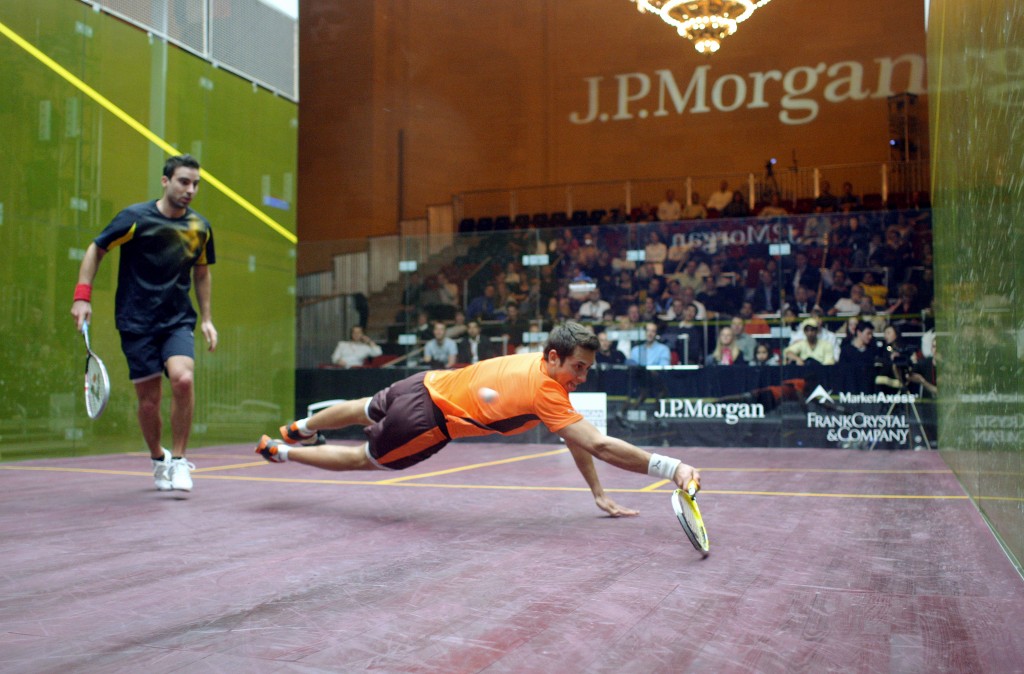
“JWSports: ‘It’s better than the bowls at Ponds Forge, Ade’” read a line on the PSALive.tv chatroom at the end of the fourth game (the live streaming was balky again, but the chatroom, filled with sleep-deprived observers from all corners of the world, was rife with good humor and incisive comments).
“Slavy: ‘clap-clap-clap.’”
‘Scherfeld: Great.’”
“Risketti: ‘Gaultier is playing excellent squash.’”
“Bartost: ‘Greg will be no3 now…it’s 1300 points for the ToC champ.’”
“Slavy: going to bed now guys—’”
And so the diamond jubilee ended. The JPMorgan Tournament of Champions was a tremendous success considering this year’s economic climate: $117,500 for prize money—the largest ever—and six out of ten sessions were completely, standing-room-only utterly sold-out, one more session than last year. Moreover, the media interest was global. The International Herald Tribune ran a story, as did dozens of local and national papers around the world. Let alone the ToC’s most faithful Internet chronicler, Squash Ukraine. Slavy, you can go to bed.


